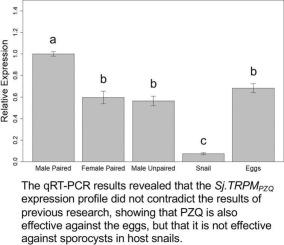Parasitology International ( IF 1.5 ) Pub Date : 2023-12-05 , DOI: 10.1016/j.parint.2023.102833
Kaho Shinozaki 1 , Masashi Kirinoki 2 , Wanlop Atcharaphan 1 , Ken-Ichi Watanabe 3 , Yuma Ohari 4 , Saki Suguta 1 , Kevin Austin L Ona 5 , Nanako Ushio 1 , Adrian Miki C Macalanda 6 , Keisuke Suganuma 1 , Noboru Inoue 1 , Shin-Ichiro Kawazu 1

|
The WHO considers schistosomiasis, which is controlled by the mass administration of the drug praziquantel (PZQ), to be a neglected tropical disease. Despite its clinical use for over four decades, PZQ remains the only choice of chemotherapy against this disease. Regarding the previous studies that demonstrated that PZQ activates the transient receptor potential (TRP) channel in Schistosoma mansoni (Sm.TRPMPZQ), the expression profile of the ortholog of this channel gene (Smp_246790.5) in S. japonicum (EWB00_008853) (Sj.TRPMPZQ) was analyzed. The relative expression of this gene in various stages of the parasite lifecycle was analyzed by quantitative real-time reverse transcription-PCR (qRT-PCR), and the expression of Sj.TRPMPZQ was observed by immunohistochemical staining using anti-serum against the recombinant Sj.TRPMPZQ protein. qRT-PCR revealed the significantly lower mRNA expression in the snail stage in comparison to other stages (p < 0.01). The relative quantity of the Sj.TRPMPZQ expression for paired females, unpaired males, and eggs was 60%, 56%, and 68%, respectively, in comparison to paired males that showed the highest expression (p < 0.05). Interestingly, immunostaining demonstrated that Sj.TRPMPZQ is expressed in the parenchyma which contains muscle cells, neuronal cells and tegument cells in adult worms. This may support the two major effects of PZQ—worm paralysis and tegument disruption—induced by channel activation. Moreover, the channel was expressed in both the eggshell and the miracidia inside, but could not be observed in sporocyst. These results suggest that the expression of Sj.TRPMPQZ corresponds to the known sensitivity of S. japonicum to PZQ.
中文翻译:

日本血吸虫吡喹酮可能靶标瞬时受体电位(TRPM)通道的表达谱分析
世界卫生组织认为血吸虫病是一种被忽视的热带疾病,血吸虫病可以通过大量服用吡喹酮 (PZQ) 药物来控制。尽管 PZQ 已在临床使用了四十多年,但它仍然是针对这种疾病的唯一化疗选择。关于先前证明 PZQ 激活曼氏血吸虫( Sm .TRPM PZQ ) 瞬时受体电位 (TRP) 通道的研究,日本血吸虫(EWB00_008853) 中该通道基因 (Smp_246790.5) 的直系同源物的表达谱 (分析了Sj.TRPM PZQ )。通过定量实时逆转录PCR(qRT-PCR)分析该基因在寄生虫生命周期各个阶段的相对表达量,并通过重组体抗血清免疫组化染色观察Sj.TRPM PZQ的表达。 Sj.TRPM PZQ蛋白。 qRT-PCR 显示,与其他阶段相比,蜗牛阶段的 mRNA 表达显着降低 ( p < 0.01)。与表现出最高表达的配对雄性相比,配对雌性、未配对雄性和卵的Sj.TRPM PZQ表达相对量分别为 60%、56% 和 68% ( p < 0.05)。有趣的是,免疫染色表明Sj.TRPM PZQ在成虫的含有肌肉细胞、神经元细胞和被膜细胞的实质中表达。这可能支持 PZQ 的两个主要作用——蠕虫麻痹和外皮破坏——由通道激活引起。 此外,该通道在蛋壳和内部的毛蚴中均表达,但在孢子被中未观察到。这些结果表明Sj.TRPM PQZ的表达对应于已知的日本血吸虫对PZQ 的敏感性。

































 京公网安备 11010802027423号
京公网安备 11010802027423号